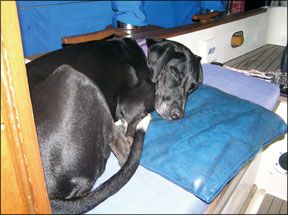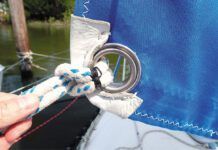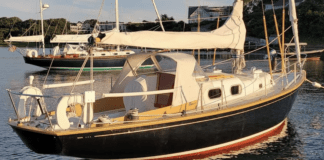Drogue Tactics
In your recent article on drogues (January 2009), you describe the Jordan Series drogue, which is compact, simple to deploy, and tremendously effective, perhaps too effective. So why doesn’t one just deploy a little less of the series drogue, or trail less of it on a longer lead line to achieve less drag. One could also attach a trip line to the end, so that you could retrieve it from rear to front one cone at a time.
Rod Kleiss
Superior Pilot, Vancouver Pilot
Bayfield, Wisc.
Circumnavigators and
Practical Sailor contributors Evans Starzinger and Beth Leonard, who produced the drogue report, have in fact made their Jordan Series
288
drogue in two lengths. They can stream both for maximum drag, or just one for reduced drag. However, even a shortened series drogue is still more difficult to recover than a single-element drogue because you have to be careful not to rip the sewn-in cones while winching. Putting a trip line on the series drogue is an interesting and debated topic. Various manufacturers all advise against it, because they think it will create a major tangle. Also, the series drogue still has significant drag when pulled in backward by a trip line. Starzinger and Leonard know of two boats that have tried trip lines on Jordan series drogues and reported that they have not had tangles. The couple is currently working on a setup that uses two standard drogues, one behind the other, with 300 feet of rode between. With this, they can crank away at the winch when recovering and they will have an arrangement that is unlikely to pull out of a wave face and lose its bite. They don’t have enough experience yet to say if this is a good idea or not. To follow this and other projects, visit
www.bethandevans.com.Heavy-Weather Tactics
Generally, I find that I prefer more flexibility in heavy-weather management aboard our yacht, Free Spirit, than a Gale Rider or sea anchor can offer. If one has limited sea room because of proximity to shipping, rocks, land, etc., then using a drogue or sea anchor has risks as well as benefits. As your January drogues article stated, it takes a couple of hours and a lot of sweat to bring in a drogue.
I have found over the past 30 years of cruising that heaving-to using a deeply reefed mainsail or a storm trysail works well. We do not use a backed jib since we find that tends to push the bow off and makes the boat crab downwind rather than stay up into the wind. Free Spirit will ride nicely in 60 knots of wind this way with fairly heavy seas.
If we have enough crew, then its often preferred to sail out the storm-at least if ones destination is downwind. One can then easily change ones mind and heave-to, if the crew gets tired.
When we go offshore, we carry a large (18-foot) Para-tech sea anchor with 600 feet of dedicated line. We havent had to use it yet, but would prefer to deploy it off the bow so that we can use the windlass to retrieve it. When doing so, we would store the anchor and rode ready to deploy in the port cockpit locker and would run the end of the line up to the bow, outside of all rigging, and then in to the bow over the bow roller and three times around the windlass and secure it to a

Billy Black
288
bow cleat. We would then feed it over the side slowly from the cockpit. This accomplishes two things: It would stop the boat more completely if close to dangers and, as mentioned, it can be retrieved more easily and quickly because we have an electric windlass to do the work for us.
Bob Gould
Free Spirit, Mariner 47
Boston, Mass.
Pearson 32 Beam
Regarding “A Question of Balance,” February 2009. By my crude measurements from the drawings you made, the 5-foot, 8-inch-wide Pearson 32 transom looks like 7 feet, 4 inches. This has significance in the context of the article, if you consider the modern trend of wider transoms and the real reason for it: fitting that large aft cabin. These seemingly small details become important in the types of comparisons you are trying to make.
Also, you can’t simply compare two foils (rudder or keel) based on the lateral area. You have to consider the shape and how that affects the ability to generate lift. If a foil with half the area can generate the same lift through a more efficient shape, then all you lose is skin drag. Thats good right? But it can go too far with very thin cross-sections that are more easily stalled, creating a boat that is hard to keep in its groove.
A nice thin rudder that slips easily through the water stalls sooner. A stalled rudder isn’t making lift and isn’t controlling the boat. And we didnt even get into the issue of the rudder broaching when the wider transom boats heel way over. At what angle of heel will a wide transom boats rudder broach compared to a narrow one? Yikes. I like Steve Killing and Doug Hunters excellent book, “Yacht Design Explained.” Also excellent is “The Symmetry of Sailing” by Ross Garrett. Lots of depth. And some more: “Principles of Yacht Design” by Larsson and Eliasson, “Seaworthiness: The Forgotten Factor” by C.A. Marchaj.
Dan Pfeiffer
Pyxis, Pearson 10m
Grand River, Ohio
Tartan 3400
My current boat, a Tartan 3400 (modern beamy design), exhibits no tendency

288
toward the kind of behavior described in your February 2009 article. Based on my experience, I believe the factors you identified in the article (hull shape and keel/rudder design, mostly) do not of themselves create the balance problems youre addressing. Clearly, a good designer can create a sweet-sailing boat with a smallish keel, a spade rudder, and lots of beam carried aft. My Tartan (beavertail shoal draft) is a case in point.
Jim Starr
Snap Dragon, Tartan 3400
New Bern, N.C.
The February article was not meant to imply that all new boats exhibited the sailing tendencies described. In fact, our testers experiences with your T3400 have been positive (February 2006), although we have not yet sailed the fin-keel version in heavier air. Several readers also wondered why the article did not touch on another related topic: stability.
Practical Sailor will be looking more closely at stability in a future issue, particularly as it relates to the new standards used by manufacturers to classify boats as offshore capable. Practical Sailor is genuinely concerned that the European Communitys Recreational Craft Directive (RCD) ratings (Category A, Category B, etc.) are misleading to new boat buyers.Waxing Painted Hulls?
While reading the February 2009 article, “Waxing Less than Poetic,” I wondered whether it is necessary to wax a painted fiberglass hull that is in good shape?
Frank Hall
Miranda, CD Typhoon
New Haven, Conn.
A non-abrasive wax/sealant or detailing spray designed for painted surfaces might protect and enhance gloss, but marine paint manufacturers are picky about which products they recommend. Anything with an abrasive should be avoided. Interlux says its Premium Teflon Marine Wax is fine for its LPU paints, while the folks at Awlgrip advise to use only their Awlwash cleaner. We will be including these types of products as our review of waxes progresses. In the meantime, we would abide by the paint makers recommendations.
Sturdee Cat
Glad to see you are considering other daysailers. My 1975 14-foot Stur-Dee Cat, Oldesquaw, probably sees many more sunsets while underway than the trophy boats. My wife, Kathy, and I are inspecting the start of the Annapolis-to-Newport race in this photo (right).
Ward Anderson
Oldesquaw, Stur-Dee Cat
Chesapeake Bay
Dogs, Windlasses, and Emergency Tillers
We recently received our mail, and I read with interest articles in the October and November 2008 issues, in particular the anchor windlass review, teak caulk update,

288
and emergency tillers piece. I replaced the teak decks on our Bowman 36, Curare, in 2000, using the Teakdecking Systems (www.teakdecking.com) technique and caulking. It has stood up well over the last eight years, the past two spent cruising in Mexico. Im glad to read that the caulking is capable of withstanding such abusive chemicals, something I never intend to subject our decks to. However, I can tell you that there is one toxic substance that does readily break down the caulking. We found this out the morning after our dog, Jessie, had been ashore and led astray by a local Mexican dog. Whatever Jessie had digested did not agree with her or the caulking-both came very loose at the seams.
Regarding anchor windlasses, I had installed a Simpson Lawrence (now Lewmar) Sprint 1000 to retrieve our 60 meters of 5/16-inch chain and 200 meters of 5/8-inch three-strand rode. The windlass was sized correctly for our 10-ton-displacement boat and worked effectively while cruising in our local Pacific Northwest waters. However, after a season of struggling to recover our rode and anchor at 2 a.m. in 30 knots in the Sea of Cortez, we upgraded to a Lewmar V3, designed for a much larger boat. It has so far performed well, but we have yet to be awakened this season with the wind howling in the rigging and with a lee shore.
Lastly, Id like to comment on your article on emergency tillers. Our Bowman came supplied with a laminated emergency tiller, which fits solidly onto the squared upper end of the rudder stock. We can steer Curare in moderate conditions with the emergency tiller, but need to reduce sail significantly in anything over 15-knots in order to maintain control. The emergency tiller does not provide any assistance, however, should the rudder become detached from the rudder stock, something that has happened to us before. I have since retrofitted the rudder with a 1-inch hole in the upper outboard end so that I can lead a line through it to steer by should that situation ever arise again.
Geoff Goodall,
Curare, Bowman 36
Vancouver, BC
Mold Remedies

288
In the January 2009 issue, you conducted a test on mildew removers. We have tried several of them on our Hunter 30 and found that the results do not last long, and some of the odors are objectionable.
I feel we have good ventilation on board even when we leave the boat. But we have finally found the answer. There is a new product that does a great job of removing mildew and keeping it away: Concrobium (www.concrobium.com). It can be purchased at Home Depot in the paint department, and works on fabric and hard surfaces, including: wood, flooring, bathroom tile, porcelain. It eliminates and prevents mold and musty odors, contains no bleach, ammonia, or volatile organic compounds (VOCs).
Howie and Anita Stein
Tiki, Hunter 30
Huntington, N.Y.
Another reader suggested a kit available on the web called OdorXit ClO2 (
www.odorxit.com) that produces small quantities of gas that kills mold and mold spores on contact. Well grab both products and see how they do.Getting 12V From 24V
Although my boat uses an engine (gasp) instead of a sail, I read and enjoy Practical Sailor each month.
In the Practical Sailor Advisor of November 2008, reader Peter Hoffman asked about a converter to run 12-volt appliances on an electric boat equipped with two 12-volt batteries in series for 24-volt service.
All he needs to do is connect his 12-volt devices to the individual 12-volt batteries. He should attempt to balance the load on each battery so they remain at close to the same level of charge, if he wishes to extend the life of those batteries.
Michael Flood
27-foot Thundercraft
Owen Sound, Ontario, Canada
As you mentioned, the uneven use configuration you suggest-unless carefully monitored-will result is dead batteries and/or reduced battery cycle life. For this and other reasons, this arrangement does not comply with standards set by the American Boat and Yacht Council (ABYC). Such an arrangement would work if you connect everything through a battery equalizer system from Vanner (
www.vanner.com), which is widely used to mix and match 12 and 24 volts. Unfortunately, the price of entry is around $750, or so it was the last time we checked. Battery equalizers automatically switch and allow for even charge and discharge of battery banks connected to them.Seasickness Remedy
I read with interest your excellent article on motion sickness (January 2009). Phenytoin is one effective prescription medication that was not listed.
It is commonly prescribed as an anti-seizure medication, but is used off label for many maladies. I have tried most of the antihistamines and scopolamines and found them ineffective. Phenytoin is the only product that prevents motion sickness for me. The risk for adverse events with phenytoin warrants caution. It appears that most side effects are from long-term therapy, not short-term exposure. There are several articles in the medical literature about phenytoin and motion sickness. Abstracts are available at
www.pubmed.com.
Dr. Brad Grant
(Dermatologist)
Melbourne, Fla.
We continue to get valuable reader reports on seasickness medication, which we hope to use for a future article. Please continue to send us your experiences with various remedies at [email protected].
Weather Classes
In your February 2009 issue, you recommended Lee Chesneaus weather seminars. The Seven Seas Cruising Association (www.ssca.org) will be reactivating its weekend workshop program, and Chesneau will be kicking it off with a weather workshop May 16-17 at the SSCA home base in Fort Lauderdale, Fla. All are welcome to attend.
Judith R. Mkam
Association Director
Seven Seas Cruising Association
As it has in the past,
Practical Sailor wholeheartedly endorses the aims of the Seven Seas Cruising Association, one of the oldest groups of its kind. Cruising sailors who have not yet participated in the SSCA online gear survey (www.ssca.org) will want to check the latest data. Practical Sailor is also working toward developing an educational component. Readers who are interested in organizing their own seminars on a variety of topics can contact Practical Sailor Technical Editor Ralph Naranjo. A link with contact information appears at www.practical-sailor.com on the home page.Teak Oils and Fires
In the January 2009 BoatU.S. magazine Seaworthy, there is an article claiming that rags used with products containing organically based oils like linseed oil can spontaneously combust. Is there any valid concern here?
Don Keskula
Naiad, 78 Pearson 10m
Oil-soaked rags are a spontaneous combustion hazard because as the oil oxidizes, heat is released. If the heat is not dissipated, it can build up enough to ignite the rags. So you need to prevent the heat from building up or dissipate the heat. It is suggested that when you are finished, they not be crumpled up in a pile but rather be placed in a water-filled container or rinsed and then laid out flat to dry.










































